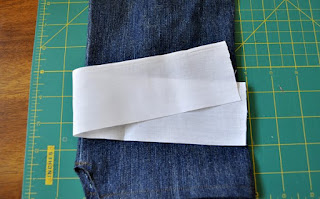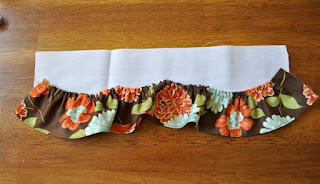This nifty little tutorial from
The Mother Huddle shows just how easy it is to add some flare to a plain old pair of jeans.
You’ll need:
§
Your jeans
§
Fabric
§
Thread to match the jeans
§
All your sewing stuff
Fabric
Cuts:
Firstly, it would be easier to have four strips the
same length, with the two bottom layers being about 50 mm wider. You would
be able to skip a few steps of the tutorial. But tutorial creator Destri liked
the fuller look you get when sewing two independent ruffles. If you
decide to take the easy route pay attention to those steps in bold – they’ll
tell you what you need to do.
For the easier method you’ll need two strips 101 x
1118mm long OR four strips 101 x
559mm.
If you’ve decided to tough it out you’ll want each
strip long enough to give plenty of gather. You’ll need two strips
measuring 64 x 1118mm, cut in half, to give four 559mm strips.
Instructions:
 |
| To prevent the ruffles from dragging the ground when finished, decide how long you’d like them to be at the start. Mark the start of the ruffles on the jeans with a pen, then fold in half with the fronts together and find your mark and cut 20cm below that to allow for the hem. Now when you open them, they will have the nice angle the legs need.
|
 |
| Make a cut at the outside seam, about 20cm in and up about 64cm up. Adjust if you are making longer ruffles.
|
 |
| Now iron over the edges like shown.
|
 |
| Sew along the edge and add some reinforcing stitches right along the top. |
 |
| Hem them up - turn them wrong side out and fold the bottom over a 6.5mm and press. Then fold over 13cm and press. Repeat on second pant leg.
|
 |
| Turn right side out and sew with a 16mm seam allowance. Tip: Using a slightly longer stitch length looks nice with denim.
|
 |
| Now we’ll move onto the ruffles. I had pinked edges so I just folded over a smidgen and pressed, like shown. You could do a double fold if you need to. Repeat on all four strips.
|
 |
| Using the same contrasting thread, sew up the bottom of the ruffle on all four strips. |
 |
Next we’ll gather. You can do this the traditional method, sew with a basting stitch and then hand gather or like turn your tension up (the higher you go, the more the gather), and lengthen your stitch length to the basting stitch. Then just sew and it will gather for you! Some machines are finicky with tension, so stick with the traditional method if you are unsure.
|
If you are using the easier method, adjust the gathers to match pant leg, sew them together at the top, then finish the seam with your sewing machine, or a serger. Then sew up the sides, giving you two cuffs. Skip the next couple few steps and go straight to sewing them to the inside of the pant leg.
 |
| Now cut a piece of fabric 64mm wide x and then the width of the pant leg where the ruffles will be sewn, plus 25mm. Just make sure you have wiggle room, so you don’t end up with a too small ruffle cuff than pant leg. If it’s a little bigger, that’s okay! I used the selvedge to make up one side, so I didn’t have to worry about fray on that edge. If you don’t have that option, just make sure to finish one long side of each strip with a serger or zigzag stitch. If you are making longer ruffles, make the strip wider to compensate.
|
 |
| Adjust the gathers on your ruffles to match the length of the strip.
|
 |
| Sew the bottom ruffle on first, to the bottom of the strip that has the selvedge or finished edge.
|
 |
| Then sew on the second ruffle so that it overlaps the bottom ruffle bout a half inch like shown. |
 |
| Then finish the seam with a zigzag stitch or your serger.
|
 |
| With the right sides together, sew up the sides with a 6.5mm allowance. Make sure to line the ends of the ruffles up! Now you have a ruffle cuff… go ahead and make the other one.
|
 |
| At this point wind your bobbin with thread that matches the jeans and use the same thread on top.
|
 |
| Almost finished! Turn the pants wrong side out as well as the ruffle cuff. Slip the ruffle cuff over the pant leg and line the top edge of the ruffle with the top of the cut opening. Then make sure it is the same all around the leg. Take the sleeve off your machine and slide the leg over. Start sewing at the outside seam, that way if your ruffle cuff is a little bigger than the pant leg, it will gather there in the end. You’re finished!
|
Looking
for a specific fabric for this project or the next? Give us a call on our
Golden Number 0861
322 839 | 0861 FAB TEX and we’ll help you find what you need.
Friend us on
Facebook or follow us on
Twitter and stay up to date with the latest news and specials.




























































